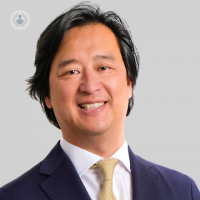iStent for glaucoma
Written in association with:The iStent is one of many procedures used to treat glaucoma, but it’s not suitable for everyone. Learn from Mr Kin Sheng Lim, an internationally renowned ophthalmologist, about who is most suitable for this treatment, what it is, potential (but very uncommon) risks and the results you can expect.

What is iStent and how does it treat glaucoma?
An iStent is a small glaucoma drainage tube that is implanted to help with the drainage of fluid out of the eye. Therefore, pressure in the eye is lowered.
It’s a very small implant (measuring only about half a millimetre) that’s made out of medically safe titanium. A unique feature is that it’s coated with heparin, which is used medically to thin a patient’s blood to prevent clotting. The objective of this coating on the titanium, once the iStent is implanted, is to prevent any blockage of the iStent from blood or cells in the eye.
Who is eligible for it?
The iStent can be used to treat patients with open-angle glaucoma, although it is usually combined with cataracts surgery at the same time.
In general, this procedure is suitable for patients with early or moderate glaucoma who would like to reduce the amount of eye drop medication they are taking. Generally, it is not suitable for patients with advanced glaucoma because other types of surgery are more suitable in that instance, such as PRESERFLO ™ or a trabeculectomy.
How is iStent performed?
The iStent procedure is performed under topical anaesthetic, usually combined with cataract surgery. It will take place in an operating theatre and the surgeon will inject some local anaesthetic into your eye prior to the insertion of the iStent. It is a very quick procedure and usually takes less than 10 minutes to perform. It’s not a painful procedure and patients recover very quickly from the operation.
Are there possible complications?
There are two potential complications but these are generally very uncommon.
- It has been reported that the iStent implant can move or dislodge from its original position. If this happens, it will be reinserted or removed.
- It’s also possible that blood clot or inflammation cells may cause blockage of the iStent.
What results can be expected?
iStent has been around for many years and we have great experience with this procedure. Although the iStent itself doesn’t lower the intraocular pressure to a very low level, it tends to be sufficiently low for most people with early or moderate glaucoma. So far, we have seen that the iStent implant can remain successful for many years after implantation. For more information on the iStent, visit the Glaukos website.
Are you uncertain about which glaucoma treatment is best for you? Get in contact with Mr Kin Sheng Lim, an expert in both traditional and cutting-edge glaucoma procedures, by clicking here.


